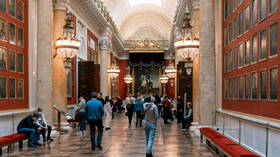Iconic Russian museum rules on foreign exhibits


One of the world’s largest museums, the State Hermitage in St.Petersburg, will not be participating in foreign exhibitions this year because of the Ukraine conflict, its director, Mikhail Piotrovsky, said on Tuesday.
“Under the current circumstances, we will not have permission to export [the art pieces] outside the Russian Federation,” he told journalists, adding that the museum will continue to host exhibitions in Russian cities.
He also noted that the Hermitage doesn’t usually lend out its pieces to foreign exhibits, but rather conducts them itself. “Various centers and Hermitage satellites existed for this. We do exhibitions with our colleagues, this is a fundamentally important thing,” he explained. “We create new meanings.”
Back in March, the Hermitage center in Amsterdam, which served as a branch of the State Hermitage museum in the Dutch capital, announced that it had cut off ties to the Russian museum in light of Russia’s military operation in Ukraine, and had renamed itself the Dutch Heritage Amsterdam, choosing to instead focus on exhibiting Dutch artists.
The move came as a number of cultural institutions around the world protested Moscow’s attack on its neighbor and refused to continue hosting Russian artworks. In April, as a number of the valuable pieces were making their way back home from museums in the EU and Japan, Finnish customs decided to seize the $46 million collection, citing EU sanctions imposed on Moscow.
Russian authorities described the move as nothing but “legal chaos” and demanded the return of its cultural property, which was traveling abroad within the framework of cooperation between museum institutions, arguing that it could not be subject to restrictions.
The diplomatic row concluded with Finnish authorities eventually ruling to return the works of art to Russia, stating that the mishap occurred due to sanctions being imposed at a hectic pace and it not being clear what did and did not fall under the sanctions list.